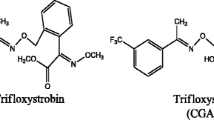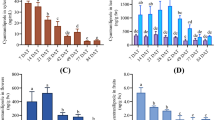Abstract
The translocation, distribution, metabolism and environmental degradation of hexachlorophene were investigated in tomato plants (Lycopersicon esculentum Mill cv. beefsteak). All plants were grown under standardized conditions and treated with leaf-applied14C-ring-labeled hexachlorophene (HCP). Treatment time ranged from 0 to 70 days. Autoradiographic analyses were performed on all plants. Selected plant tissues were extracted and chromatographed, using thin layer (TLC) and gas liquid chromatography (GLC).
Hexachlorophene was not translocated from the plant leaves. No metabolites of hexachlorophene were found. A slight, but statistically nonsignificant, amount of HCP was lost from the leaves and the inert controls.
At the end of the 70-day treatment, based on TLC and regression analysis of thin layer chromatographic plates, averages of 89.5% and 75.9% of the applied HPC remained unaltered on the treated plants and controls, respectively. This indicated that 10.5% and 24.1%, respectively, of the original HCP had been altered. Differences between the treatments and controls were statistically significant after 28 days of exposure. Further analyses of the above data, using gas chromatographic methods, showed that as many as 14 peaks were found in the treated samples and the controls, including the parent material.
Ultraviolet photolysis seemed to be the mechanism responsible for alteration of the hexachlorophene. Three extracted chlorinated compounds have been identified by GC-mass spectral (MS) analysis including 2,2′-dihydroxy-3,5′, 6,6′-tetrachlorodiphenylmethane, 2,2′-dihydroxy-3,5,5′,6,6′-pentachlorodiphenylmethane, and 2,2′-dihydroxy-3,3′,5,5′,6,6′-hexachlorodiphenylmethane (parent HCP). Eleven other electrophylic compounds have been found in various treated plant or control extracts. Further analyses will be necessary to verify the identification of the other degradation products.
Similar content being viewed by others
References
Abbel-Nabi, H., and J. B. Sinclair: Inhibition ofXanthomonas malvaceanum by certain fungicides and antibiotics. Plant Dis. Rep.48, 268 (1964).
Amon, D. I.: Microelements in culture-solution experiments with higher plants, Am. J. Bot.25, 322 (1938).
Bidleman, T. F., and C. E. Olney: Chlorinated hydrocarbons in the Sargasso sea atmosphere and surface water. Science183, 516 (1974).
Buhler, D. R., M. E. Rasmusson, and H. S. Nakaue: Occurrence of hexachlorophene and pentachlorophenol in sewage and water. Env. Sci. Technol.7, 929 (1973).
Chase, G. D., and J. L. Rabinowitz: Principles of radioisotope methodology, 2nd Ed., p. 202. Minneapolis: Burgess Pub. Co. (1962).
Chung, H. L., W. C. Ts'ao, H. C. Hsu, C.-H. Kuo, H.-Y. K'O, L.-S. Mo. H.-Y. Chang, H.-T. Chuo, and W.-H. Chou: Hexachlorophene (G-11) as a specific drug againstChlonorchaisis sinensis; Its efficacy and toxicity in experimental and human infection. Chin. Med. J.82, 691 (1963).
Crafts, A. S., and S. Yamaguchi: The autoradiography of plant materials, p. 143. Division of Agricultural Sciences, University of California: Berkeley (1964).
Duggan, R. E. (ed): Pesticide analytical manual, Vol. 2, Methods for individual pesticide residues, Pesticide Ref. Sec. 180.302, Hexachlorophene. Washington: U.S. Dept. of Health, Education and Welfare, Food and Drug Administration (1974).
Dyer, D. R., and R. D. Gafford: Some characteristics of a thermophilic blue-green alga. Science134, 616 (1961).
Gandolfi, A. J.: Hexachlorophene: Its absorption, distribution, excretion, and biotransformation in the rat and rabbit and in vitro interaction with rat liver microsomes. Ph.D. Dissertation, p. 80. Oregon State University, Corvallis, Oregon (1973).
Gandolfi, A. J., and D. R. Buhler: Metabolism of hexachlorophene in the rabbit, excretion, tissue distribution, and characterization of the urinary glucronide conjugate. J. Agri. Food Chem.25, 21 (1977).
Gutenmann, W. H., and D. J. Lisk: GLC determination of hexachlorophene in several agricultural samples. J. Assoc. Off. Anal. Chem.53, 522 (1970).
Heck, W. W., J. A. Dunning, and I. J. Hindowi: Interaction of environmental factors on the sensitivity of plants to air pollution. J. Air Pol. Control Assoc.15, 511 (1965).
Hueck, H. J., D. M. M. Adema, and J. R. Weigmann: Bacteriostatic, fungistatic and algistatic activity of fatty nitrogen compounds. Appl. Microbiol.14, 308 (1966).
Johnston, V. D., and P. J. Porcaro: Separation of hexachlorophene from organic matter prior to spectrophotometric estimation. Anal. Chem.36, 124 (1964).
Kimbrough, R. D.: Hexachlorophene: Toxicity and use as an anti-bacterial agent. Essays Toxicol.7, 99 (1976).
Kodak Ltd.: Radiography: Kodak data book of applied photography. London (1958).
Ma, R. M.: Hexachlorophene: A bibliography. F. D. A. By-Lines5, 213 (1974).
Marquardt, R. P., H. P. Burchfield, E. E. Storrs, and A. Bevenue: 2,4-Dichlorophenoxyacetic Acid. In G. Zweig (ed.): Analytical methods for pesticides, plant growth regulators, and food additives. Vol. 4, p. 113. Herbicides. New York: Academic Press (1964).
Miller, L. D., and E. M. Bellet: Personal communication, Marion Laboratories, Inc., 10236 Bunker Ridge Rd., Kansas City, Mo. 64132 (1977).
Noori, D. D.: Personal communication. Thorton Laboratories, Inc., Tampa Florida (1969).
Owen, J. H., and J. D. Gay: Test of soil fungicides under uniform conditions for control of cotton damping-off caused byRhizoctonia solani. Plant Dis. Rep.48, 480 (1964).
Prentice, N., A. D. Dickson, B. A. Burkhart, and N. N. Standridge: The influence of plant-growth regulators applied to barley during malting on properties of malt. Cereal Chem.40, 208 (1963).
St. John, L. E., Jr., and D. J. Lisk: The excretion of hexachlorophene in the dairy cow. J. Agri. Food Chem.20, 389 (1972).
Shaffer, G. W., E. Nikawitz, M. Manowitz, and H. U. Daeniker: Photodegradation of hexachlorophene and related polychlorinated phenols. Photochem. Photobiol.13, 347 (1971).
Shiima, H., and R. Nishiyma: 2,2′-Methylenebisphenol derivatives as herbicides. Jap. Patent 8995, (1963).
Silvernale, J. N., H. L. Joswick, T. R. Corner, and P. Gerhardt: Antimicrobial actions of hexachlorophene: Cytological manifestations. J. Bacteriol.108, 482 (1971).
Sims, J. L., and F. K. Pfaender: Distribution and biomagnification of hexachlorophene in urban drainage areas. Bull. Environ. Contam. Tox.14, 214 (1975).
Stanley, C. W.: Derivatization of pesticide-related acids and phenols for gas chromatographic determination. J. Agr. Food Chem.14, 321 (1966).
Stavinoha, W. B., and S. T. Weintraub: Estimation of choline and acetylcholine in tissue by pyrolysis gas chromatography. Anal. Chem.46, 757 (1974).
Van Auken, O. W., and M. Hulse: Extraction and quantification of hexachlorophene from several plant tissues. J. Assoc. Off. Anal. Chem.60, 1081 (1977a).
—: Extraction, GLC detection, and quantification of hexachlorophene residues from plant storage tissues high in lipid content. J. Assoc. Off. Anal. Chem.60, 1087 (1977b).
—: Hexachlorophene. In G. Zweig and J. Sherma (ed.): Analytical methods for pesticides, plant growth regulators, and food additives, Vol. 10, p. 189. New and updated methods. New York: Academic Press. In press (1978a).
-: Translocation and metabolism of leaf applied hexachlorophene in peanuts. Physiologia Plantarum. In press (1978b).
Wiebel, F. J., D. F. Crossman, and D. J. Fieldhouse: Evaluation of bactericidal and nonbactericidal compounds for control of bacterial spot of pepper. Plant Dis. Rep.49, 748 (1965).
Wit, J. G., and H. Van Genderen: Some aspects of the fate of hexachlorophene (2,2′-methylene bis (3,4,6-trichlorophenol)) in rabbits, rats, and dairy cattle. Acta Physiol. Pharmacol. Neerl.11, 123 (1962).
Wright, W. R.: Prevention and control of bacterial and fungal plant diseases. U.S. Patent 3,420,936 (1969).
Author information
Authors and Affiliations
Rights and permissions
About this article
Cite this article
Van Auken, O.W., Hulse, M. Translocation, distribution, and environmental degradation of hexachlorophene in tomatoes. Arch. Environ. Contam. Toxicol. 8, 213–230 (1979). https://doi.org/10.1007/BF01056326
Received:
Accepted:
Issue Date:
DOI: https://doi.org/10.1007/BF01056326




